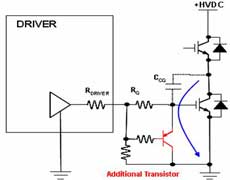berni80
Member level 2
active clamping
Hi,
has anyone an experience with the active clamp on IGBT driver?
I'm using an IGBT IC driver without it, but I would like to add this feature
with some external components.
I find this topology (see below) but I'm not so convinced because it isn't really "active".
It is just like to have different Rgate for ON and OFF (with Rgate OFF approximately zero). The gate charge through Rg and discharge through red transistor.

More useful is a driver like the ST TD350 or the AVAGO ACPL-332J.
Here the DSs:
https://www.st.com/stonline/products/literature/ds/9525/td350.pdf
The clamp is active only when the IGBT OFF transient is finished and it doesn't affect the OFF switching phase.
Could you suggest me some circuit to implement it or some doc to refer to?
Thanks
[/url]
Hi,
has anyone an experience with the active clamp on IGBT driver?
I'm using an IGBT IC driver without it, but I would like to add this feature
with some external components.
I find this topology (see below) but I'm not so convinced because it isn't really "active".
It is just like to have different Rgate for ON and OFF (with Rgate OFF approximately zero). The gate charge through Rg and discharge through red transistor.

More useful is a driver like the ST TD350 or the AVAGO ACPL-332J.
Here the DSs:
https://www.st.com/stonline/products/literature/ds/9525/td350.pdf
The clamp is active only when the IGBT OFF transient is finished and it doesn't affect the OFF switching phase.
Could you suggest me some circuit to implement it or some doc to refer to?
Thanks
[/url]